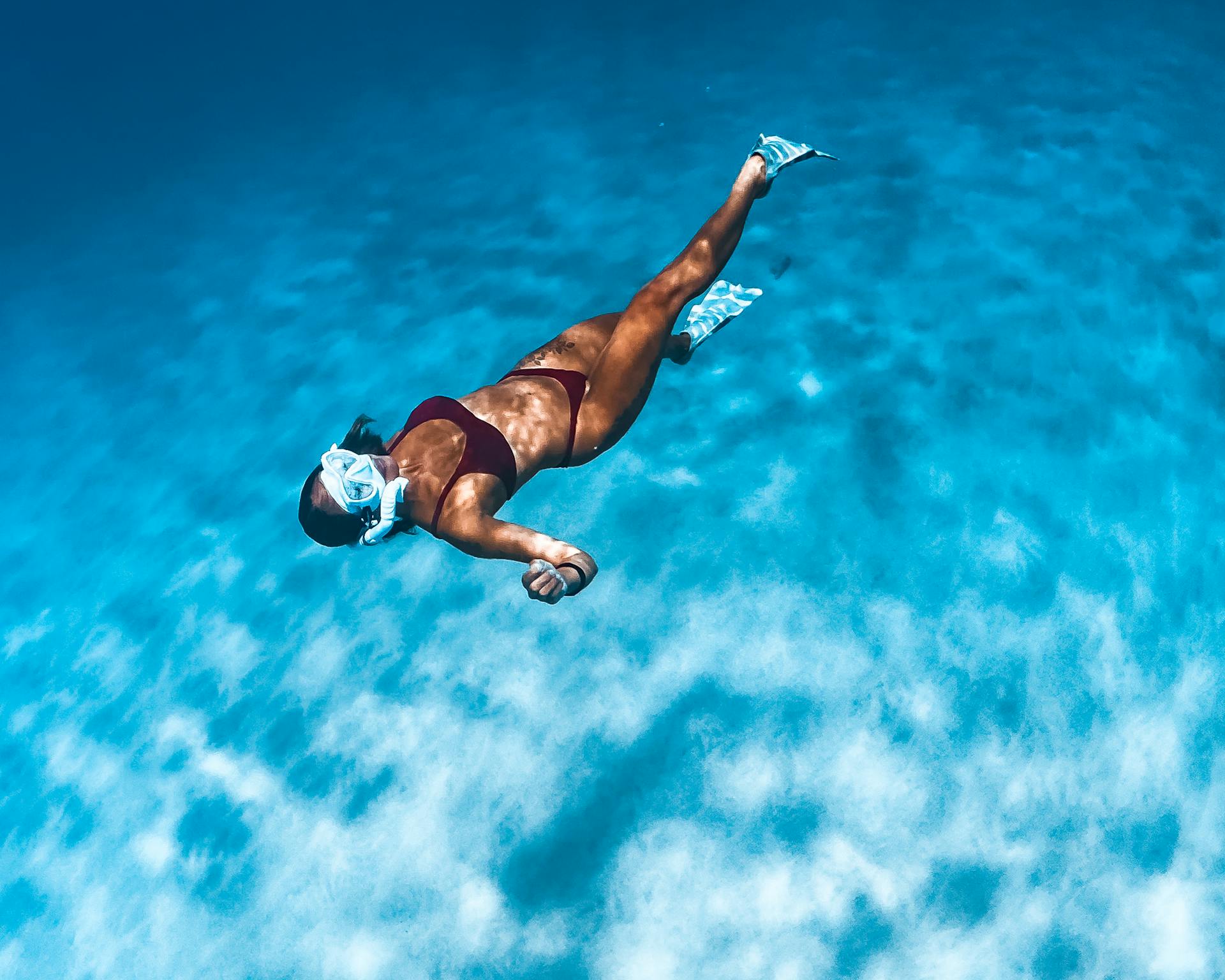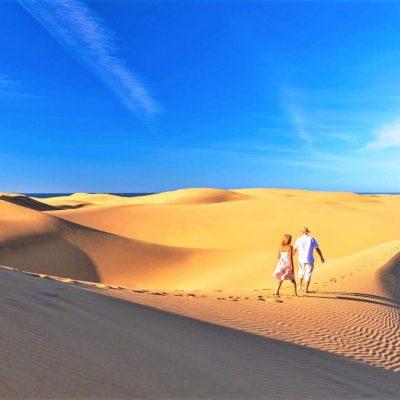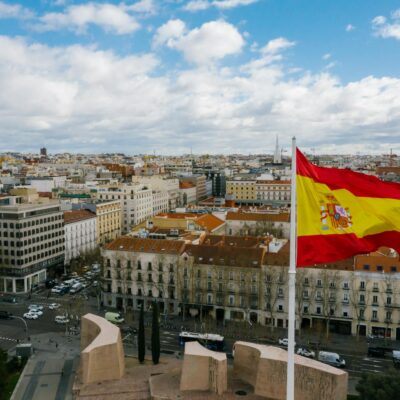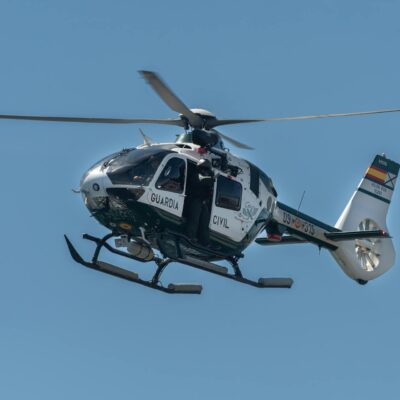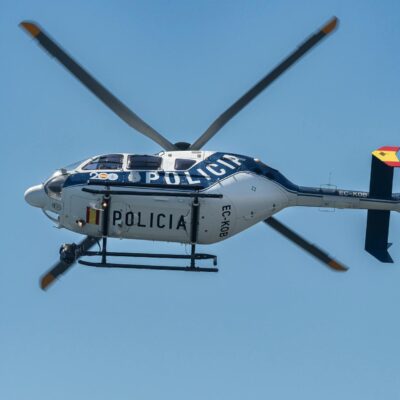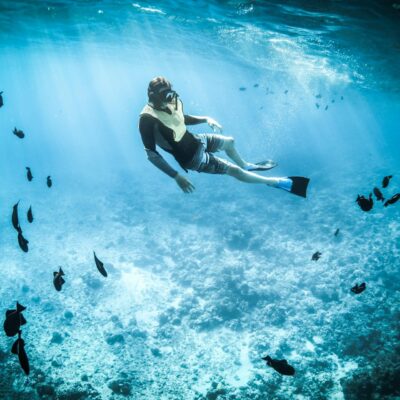Fuerteventura is one of the best islands in the Canaries for easy snorkeling. You will find turquoise lagoons, lava reefs, calm bays and long sandy beaches where you can slip into the water with a mask and fins. This guide shows you the best snorkeling spots in Fuerteventura, how to choose the right day, what marine life you can expect, where to go with children and which safety rules you should always follow.
Contents
- Best snorkeling in Fuerteventura: top 7 spots
- Fuerteventura snorkeling map (text guide)
- Best places to go snorkeling in Fuerteventura
- When to go and sea conditions
- Fuerteventura sea life and what you will see
- Beginner and family friendly snorkeling
- Gear and comfort
- Safety essentials and important disclaimer
- Easy self guided snorkeling itineraries
- Frequently asked questions
- Responsible snorkeling
- Legal disclaimer
Best snorkeling in Fuerteventura: top 7 spots
If you only have a few days on the island, these are the best snorkeling spots in Fuerteventura to focus on.
- El Puertito, Isla de Lobos near Corralejo for shallow clear lagoons and rich fish life
- El Cotillo lagoons for calm pools protected by lava reefs
- Caleta de Fuste for easy entry and a safe bay with services
- El Jablito for a simple village cove with clear water
- Costa Calma rocky corners on calm days for relaxed reef cruising
- Morro Jable and Jandia points for long beaches and rocky tongues with reef fish
- Playa Chica in Puerto del Rosario for a quick urban snorkel near the capital
Fuerteventura snorkeling map (text guide)
This is a simple text map that shows where the main snorkeling areas sit around the island.
North and northwest
- El Cotillo lagoons near the village of El Cotillo
- Open west coast beaches nearby are usually for surfing, not for snorkeling
North and Corralejo area
- Corralejo town beaches and rocky corners on calm days
- Isla de Lobos with El Puertito lagoons reached by boat from Corralejo
Central east coast
- Caleta de Fuste large sheltered bay
- Playa Chica in Puerto del Rosario
- El Jablito small fishing village cove
South and southeast
- Costa Calma area and nearby small rocky beaches
- Morro Jable and Jandia long beaches with rocky points at each end
Best places to go snorkeling in Fuerteventura
Below you will find more detail on each main snorkeling area in Fuerteventura, along with tips on when to go and what to look for in the water.
1) Isla de Lobos – El Puertito near Corralejo
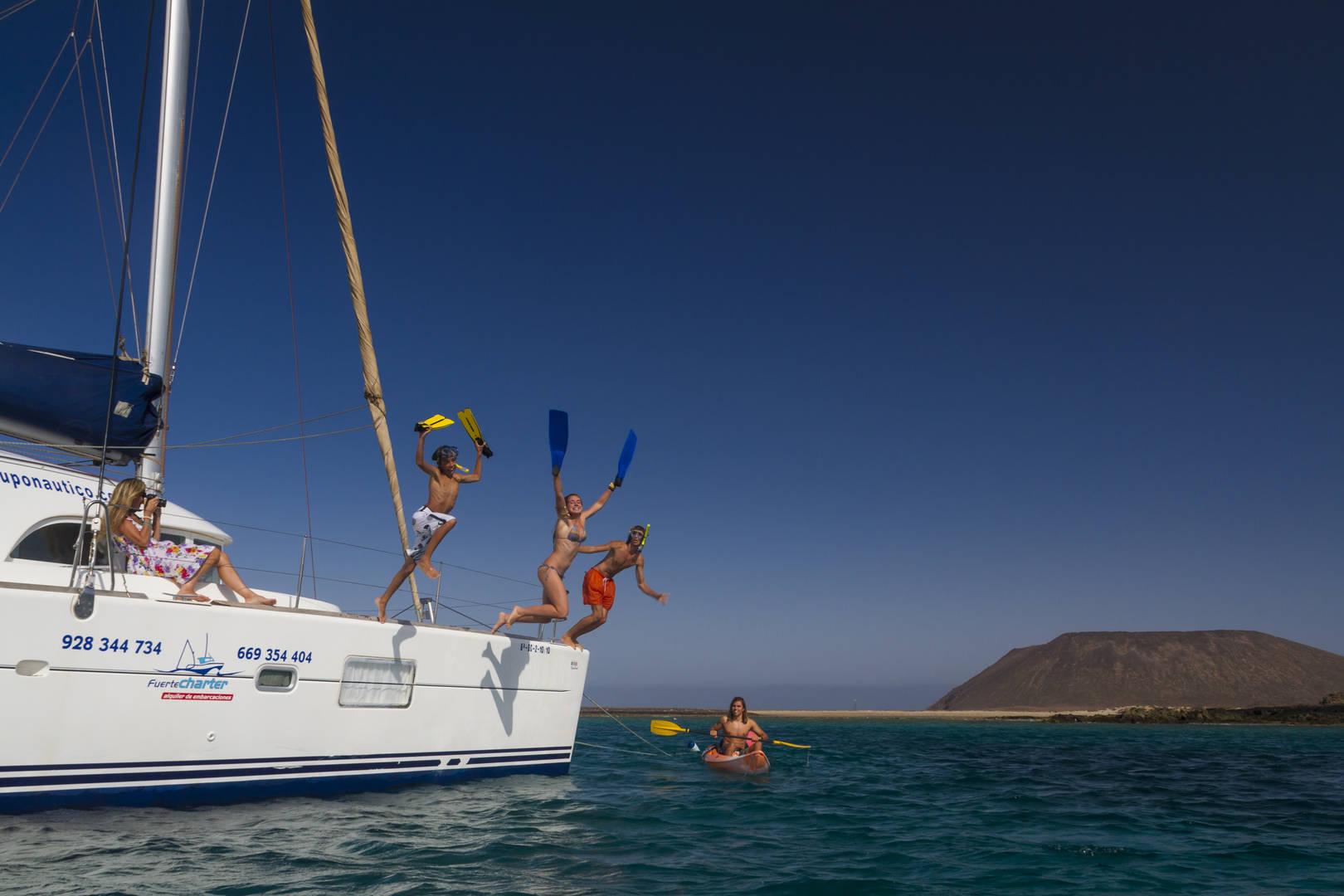
A short boat ride from Corralejo takes you to the small island of Lobos. At El Puertito you will find shallow turquoise lagoons with white sand and rocky patches. On calm days it is one of the most beautiful places to snorkel in Fuerteventura.
- What you will see: salema (bream), damselfish, ornate wrasse, parrotfish, trumpetfish and sometimes cuttlefish or octopus close to the rocks
- Best conditions: light wind and no strong swell, mornings are usually clearer
- Notes: Lobos is a protected area, facilities are limited, bring water, shade and follow rules about where you can swim and walk
2) El Cotillo lagoons – Los Lagos and La Concha
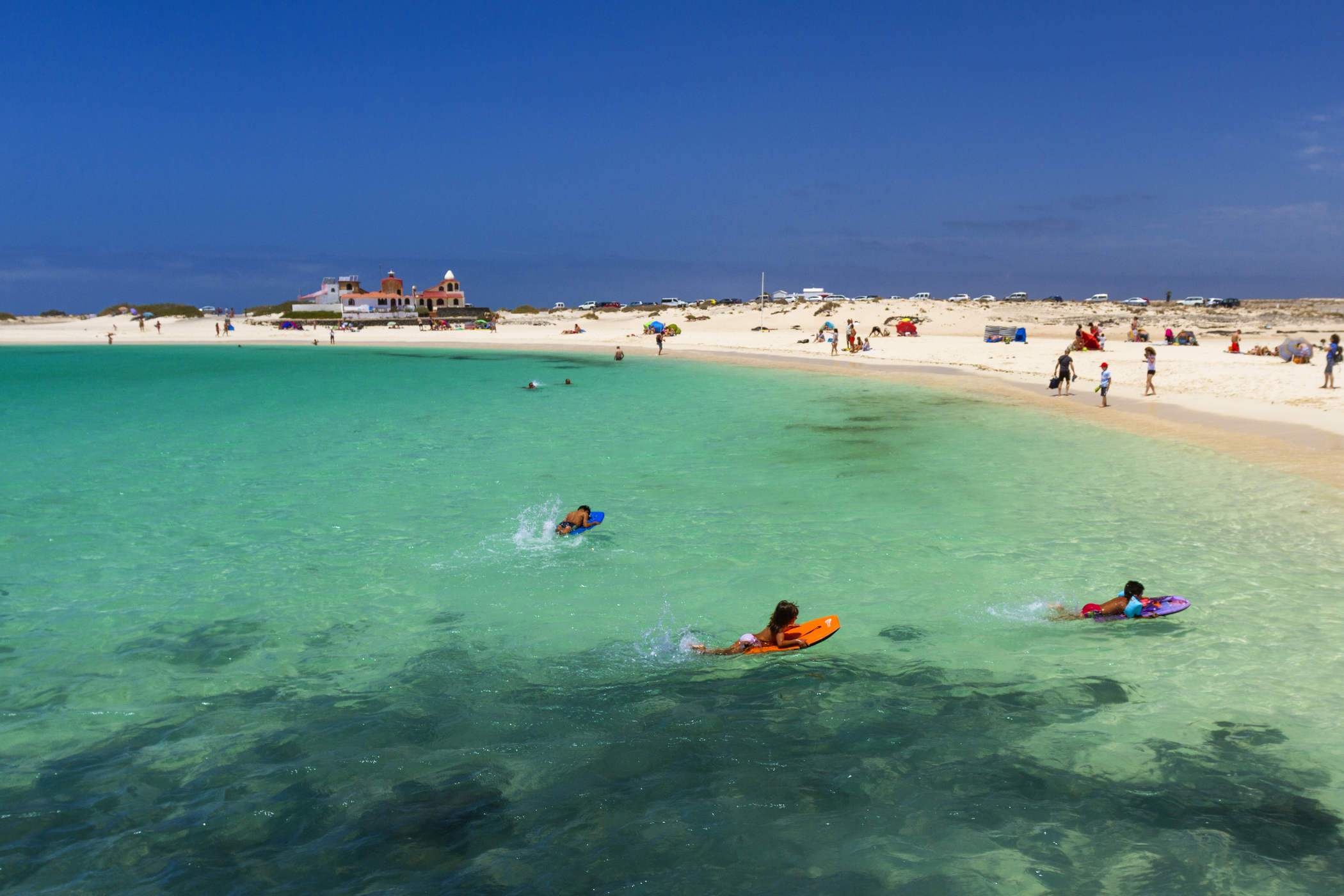
North of El Cotillo village, natural lava reefs create calm lagoon like pools. At the right tide these are perfect for first snorkels and relaxed floating over sand and rock.
- Best tide: mid to high tide gives more depth over the reef
- What you will see: parrotfish, wrasse, damselfish, small gobies and flatfish on sandy patches
- Important: the open ocean beaches west of town are usually for surfing, not for snorkeling, swell and currents there can be strong
- Footwear: reef shoes or booties help with sea urchins and rough rock
3) Caleta de Fuste – El Castillo bay
Caleta de Fuste is one of the easiest places to start snorkeling in Fuerteventura. The large bay is sheltered and has sandy entries, with hotels, cafés and shops along the promenade.
- Best area: along the rocky arms and harbour walls where fish like to gather
- What you will see: salema shoals, damselfish, wrasse, crabs and sea stars between boulders
- Why go: very convenient and great for children, older visitors and anyone who wants calm conditions
4) El Jablito – small fishing village cove
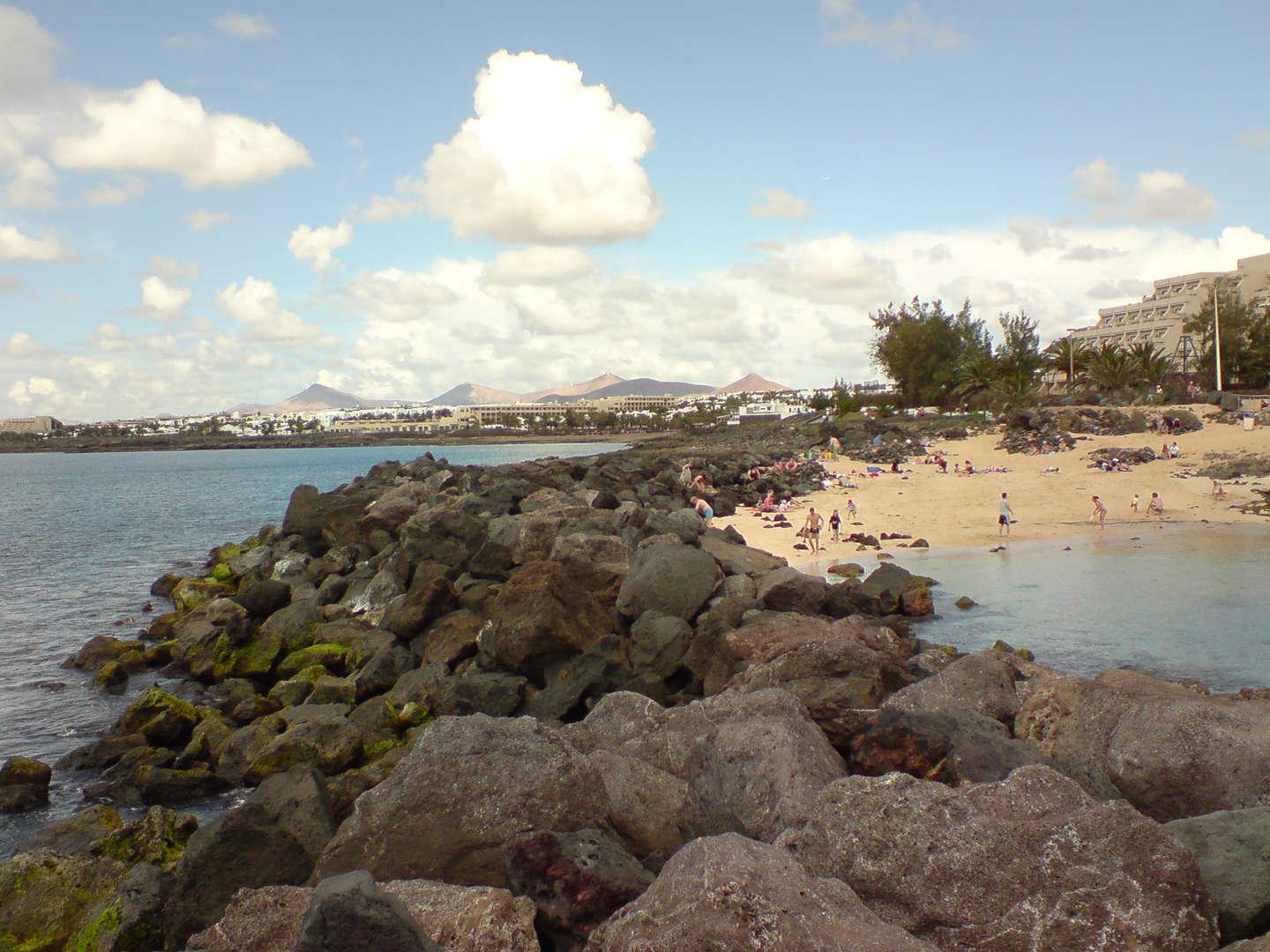
El Jablito is a quiet fishing settlement with a small inlet that is often protected from wind and swell. It feels very local and simple, with easy entries from the beach.
- What you will see: wrasse, damselfish, salema, small shoals and sometimes cuttlefish near rocks
- Best for: relaxed snorkels when other spots are too windy
5) Costa Calma area – south east
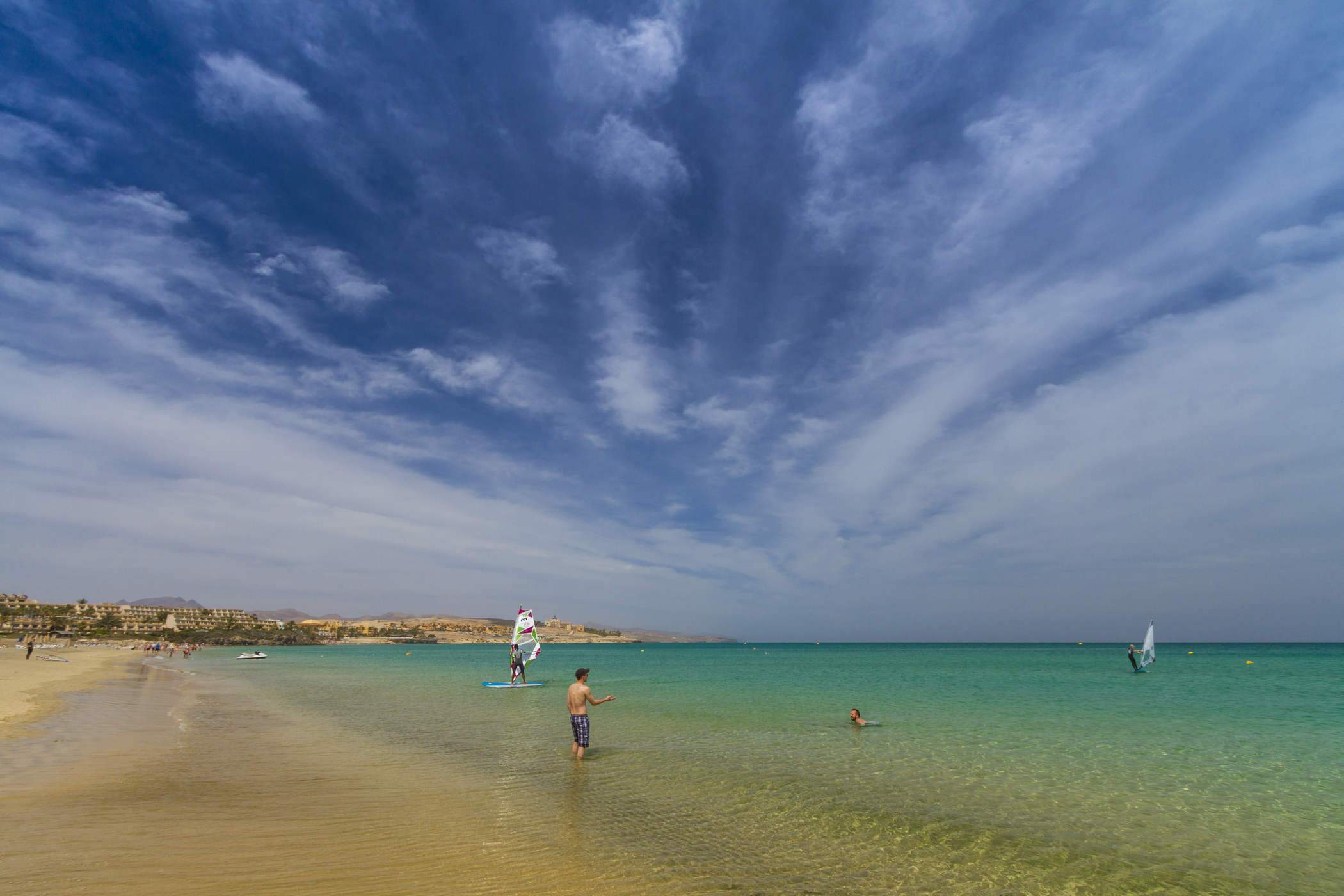
Costa Calma is known for long sandy beaches and steady breeze. On calm days with low wind you can snorkel the rocky corners near small bays such as Playa de las Caletillas.
- Best days: when trade winds are light in the morning and waves are small
- What you will see: parrotfish, wrasse and damselfish around the rocks
- Plan B: if wind picks up, switch to more sheltered east coast bays like Caleta de Fuste or El Jablito
6) Morro Jable and Jandia peninsula – south
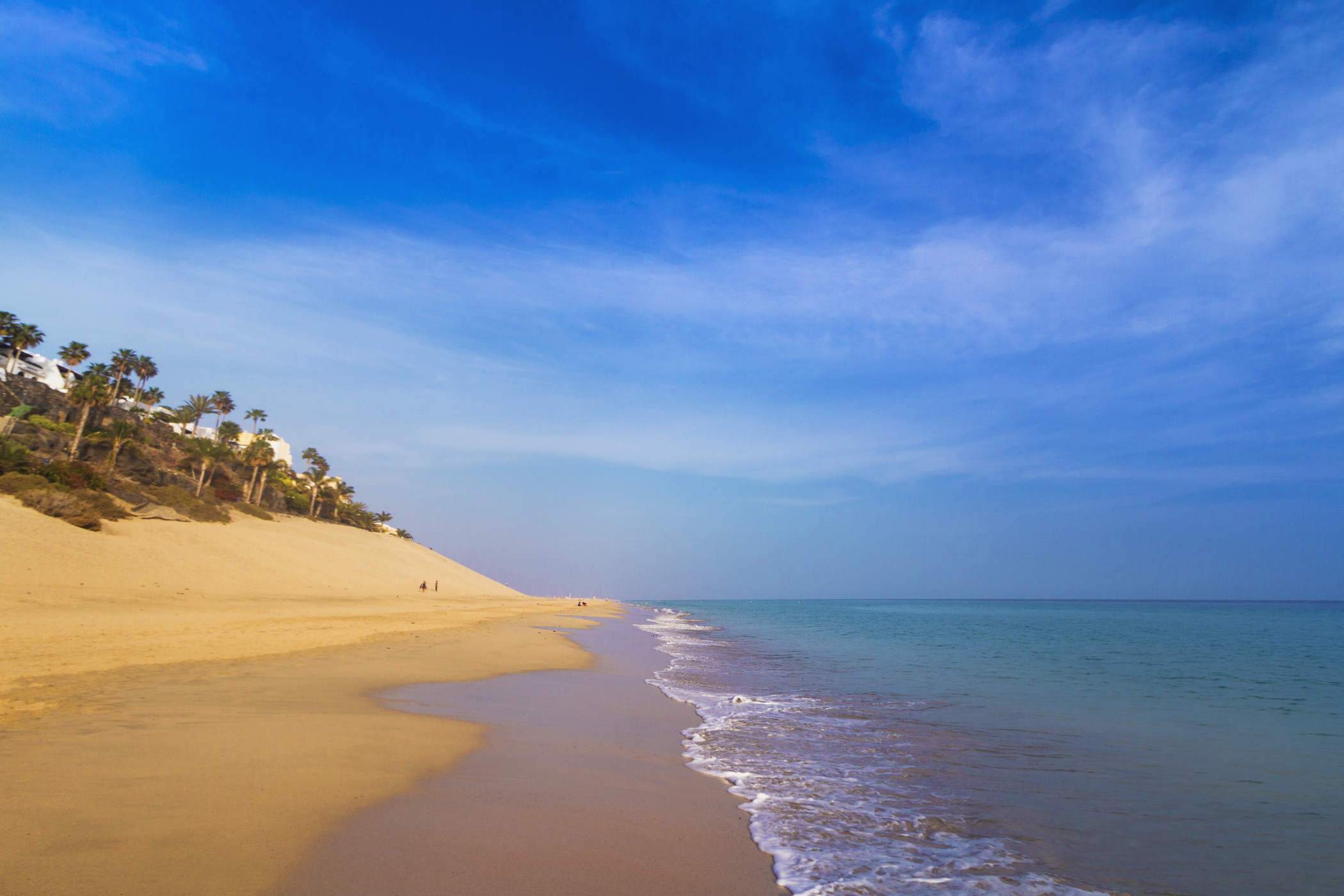
The long beaches of Morro Jable and Jandia have clear water on many days, with rocky points near the lighthouse and by the town that shelter fish.
- What you will see: parrotfish, trumpetfish, octopus hideouts among lava stones and sometimes rays gliding over sandy channels
- Safety: always stay inside the swim buoys and away from boat or jet ski lanes
7) Playa Chica – Puerto del Rosario
Playa Chica is a small sheltered urban beach in the capital. It is ideal for a quick snorkel if you are staying nearby or passing through town.
- Best area: along the rocky edges on each side of the small bay
- What you will see: damselfish, wrasse, small bream and occasional surprises on calm days
When to go and how to choose the day
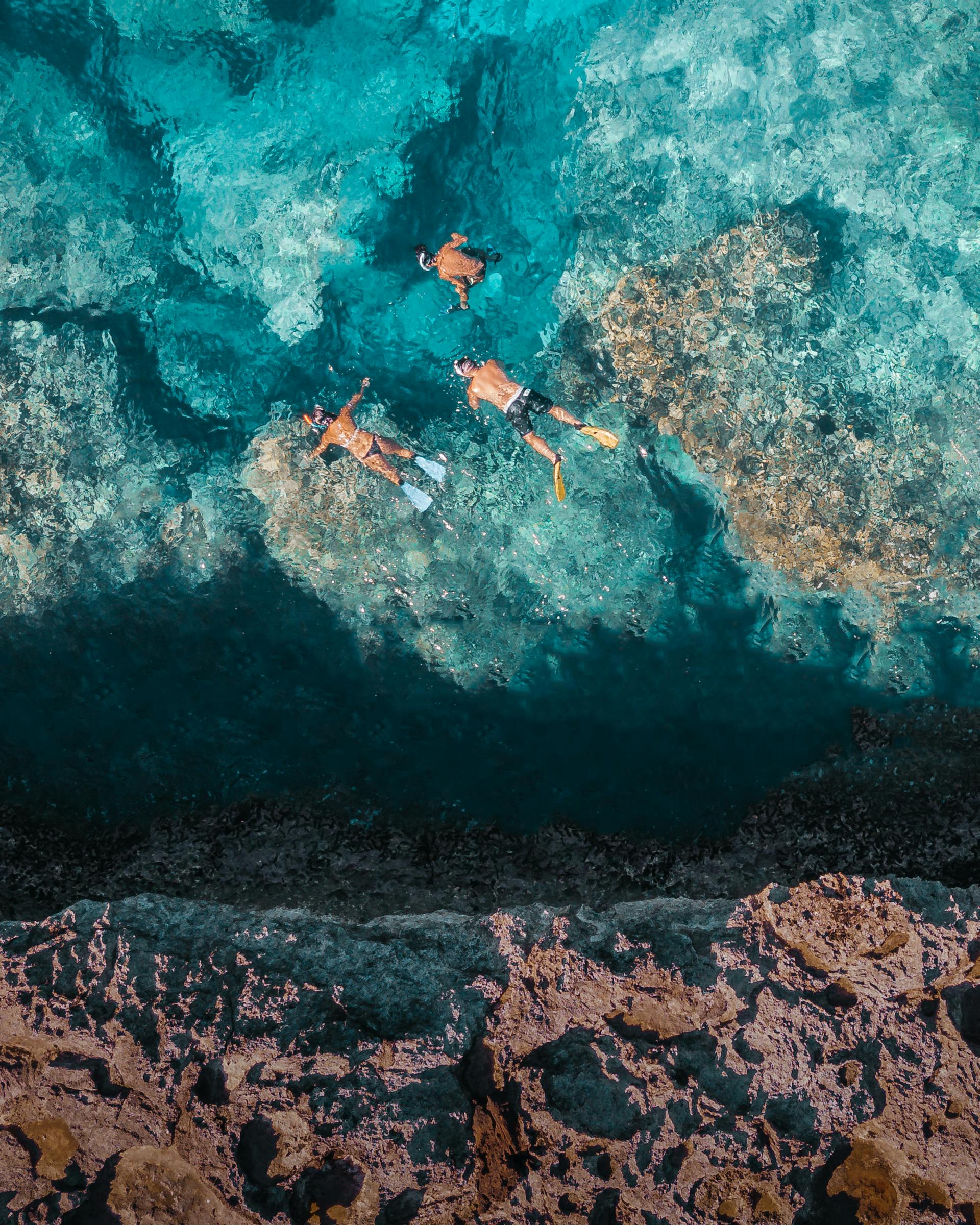
- Water temperature: roughly 24 to 25 degrees between August and October, around 18 to 20 degrees between January and April
- Visibility: commonly 10 to 25 meters and often clearest in late summer and early autumn when seas are calmer
- Best months: June to October for warm water and frequent calm mornings, the rest of the year is fine if you pick sheltered bays
- Wind: trade winds tend to build by late morning, so mornings are usually calmer and clearer
- Tide: for lagoon reefs like El Cotillo, mid to high tide gives enough depth, for simple sandy bays, tide is less important than wind and swell
- Plan B: if the north or west is windy or rough, move to east coast areas such as Caleta de Fuste or El Jablito
Fuerteventura sea life and what you will see
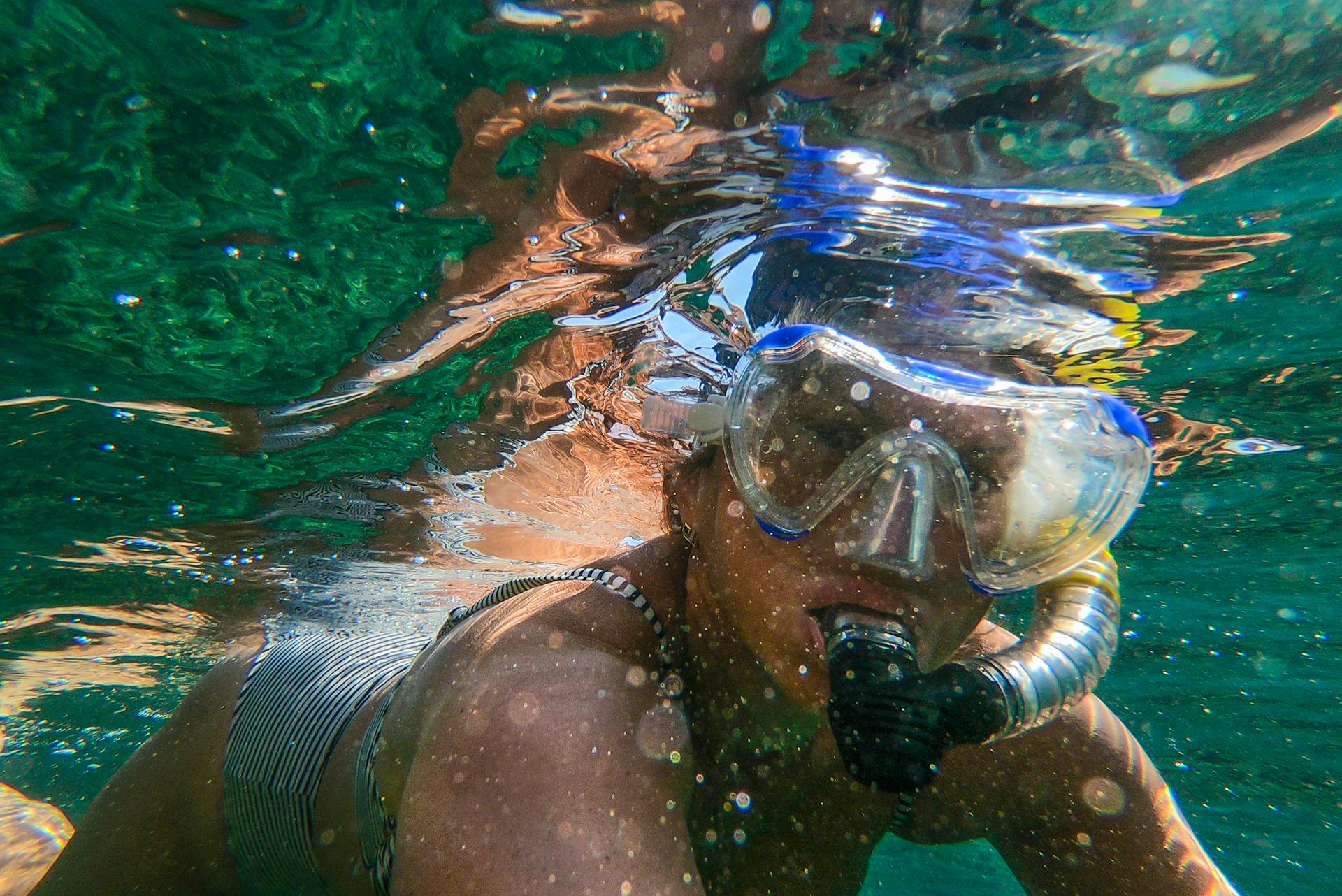
Snorkeling in Fuerteventura is not about coral, but about clean water and lively fish communities. You can expect:
- Parrotfish (vieja) with bright colors and strong beaks
- Ornate and rainbow wrasse constantly moving around rocks
- Blue or sergeant damselfish defending small territories
- Salema and zebra bream cruising in small groups
- Trumpetfish hovering around ledges
- Gobies and flatfish on sandy patches
- Cuttlefish and octopus for patient observers near rock holes
- Rays from time to time over deeper sandy tongues
Sea turtles sometimes pass near shore but this is rare, so treat any sighting as a bonus and keep a respectful distance.
Family friendly and beginner picks
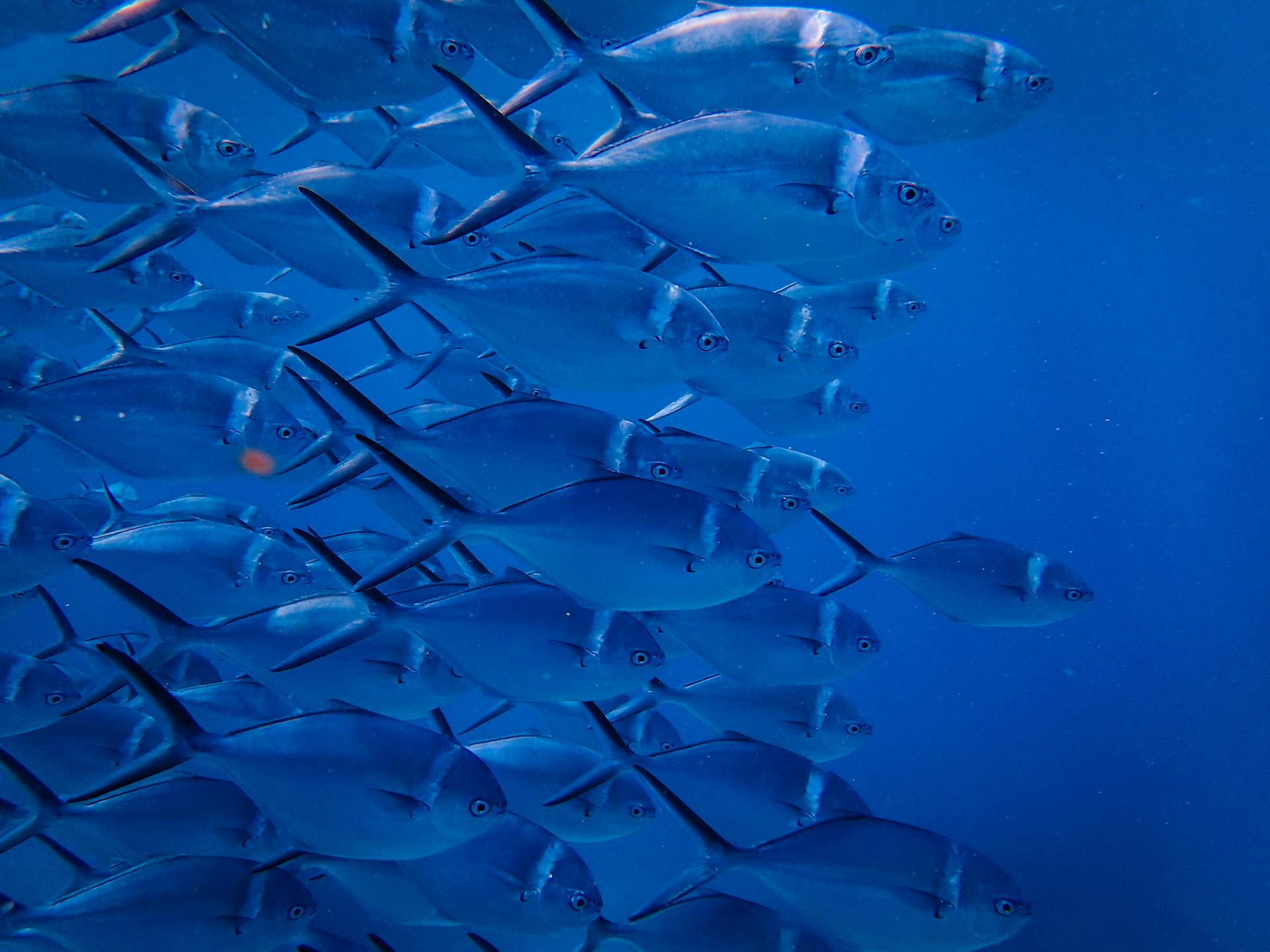
Some places are much easier for beginners and children than others. If you are new to snorkeling, focus on these spots first.
- El Cotillo lagoons at mid to high tide, pool like conditions and gentle slopes
- Caleta de Fuste with sandy entries, services nearby and often lifeguards in season
- El Jablito with a calm village inlet that is easy to enter and exit
- El Puertito on Lobos on calm days, very shallow clear water over pale sand
Gear and comfort
- Mask and snorkel: choose a low volume mask that seals well to your face and a simple snorkel that you find easy to clear
- Fins: short fins are perfect for shore entries and gentle reef swimming
- Wetsuit or rash guard: in summer many people are fine with a rash guard, from November to May a two to three millimeter suit keeps you comfortable for longer sessions
- Booties: neoprene boots protect from sea urchins and sharp lava rock
- Sun protection: use reef safe sunscreen and long sleeve tops, the sun is strong even on breezy days
- Safety float: a bright float or buoy makes you more visible to other water users
Safety essentials and important disclaimer
Snorkeling in Fuerteventura can be very safe if you respect the sea. Conditions change with wind, tide and swell, and can be very different between the open west coast and sheltered east bays. Use the following guidance as a starting point and always trust local information.
- Check the flag system on lifeguarded beaches. A red flag means no swimming. Even if the sea looks calm, there can be strong currents or dangerous waves.
- Be aware of currents. If you feel the water pulling you sideways along the beach or outwards from the shore, turn back and return to shallow water immediately.
- Respect the west coast. Open ocean beaches near El Cotillo and on the west side often have strong surf and powerful currents. Many days they are better for walking and photos than for snorkeling.
- Avoid rocky entries in swell or strong wind. Waves can knock you on to lava rock and make exits difficult. Choose sandy entries when the sea is lively.
- Stay inside swim zones. Keep within buoy lines where they exist and never cross into boat or jet ski lanes, harbours or busy channels.
- Keep distance from breakwaters and harbour walls. Waves can rebound off hard structures with unexpected force.
- Watch your step on rocks. Sea urchins live in holes and cracks. Look where you place your feet and wear booties whenever possible.
- Check for jellyfish or Portuguese man o war. Ask lifeguards and look for warning signs. If you see many in the water or washed on the beach, it is better to skip the session.
- Use a safety float. A bright float helps others notice you and gives you something to hold if you feel tired.
- Do not snorkel alone at remote spots. Go with a partner and tell someone on land where you are going and when you plan to return.
- Exit the water early if conditions change. If visibility drops, waves increase or you feel cold or tired, end the session in a calm and controlled way.
Important disclaimer
Sea and weather conditions around Fuerteventura can change quickly and can vary greatly from one beach to another. The information in this guide is general and cannot replace local advice on the day. Always follow signs, flag systems and lifeguard instructions. You are responsible for your own safety and for assessing whether conditions are suitable for you and your group. If you are not sure, do not enter the sea.
Easy self guided snorkeling itineraries
Corralejo and Lobos classic
Take a morning boat from Corralejo to El Puertito on Lobos for shallow snorkel circuits, enjoy a picnic in the shade and return to Corralejo for a dune walk or a sunset on the town beach.
Northwest lagoons day
Start at El Cotillo lagoons at mid to high tide, relax in calm pools, then head into the village for coffee or ice cream and finish the day with a stroll along La Concha beach during golden hour.
East coast family loop
Begin with a warm up snorkel in Caleta de Fuste, take a break on the promenade for lunch, then move on to El Jablito for a quiet afternoon in the village cove.
Frequently asked questions
Is Fuerteventura good for beginner snorkeling?
Yes. Spots like El Cotillo lagoons, Caleta de Fuste, El Jablito and El Puertito on Lobos during calm days are very beginner friendly.
Do I need a wetsuit to snorkel in Fuerteventura?
In summer many people snorkel in just swimwear and a rash guard. From November to May, a two to three millimeter suit makes the experience more comfortable, especially if you stay in the water for a long time.
Where is the clearest water in Fuerteventura?
On many days the clearest water can be found around Isla de Lobos and in the El Cotillo lagoons. Calm mornings on the east coast can also offer excellent visibility.
Do I need a permit for Lobos?
Access rules for Lobos can change and there may be limits on visitor numbers. Check locally in Corralejo and always follow current regulations about landing and swimming areas.
Are there dangerous animals when snorkeling?
Most marine life is harmless if you do not touch or disturb it. Jellyfish and Portuguese man o war can appear, especially in certain conditions. If they are present in large numbers, it is safer to stay out of the water.
Responsible snorkeling
- Do not touch, chase or feed marine animals, this stresses them and changes natural behaviour
- Keep your fins away from seagrass meadows and fragile algae on rocks
- Use reef safe sunscreen and allow it to absorb before entering the sea
- Never throw rubbish or food into the water and take all waste back with you
- Avoid standing on living rock or any area with growth, use sand patches to rest if needed
Legal disclaimer
The information in this article is offered for general guidance only. It is not personal safety advice and does not guarantee that any location or activity is safe on a particular day. Ocean and weather conditions can change quickly in Fuerteventura. Always check local conditions, obey signs and flags, and follow instructions from lifeguards and authorities. By entering the sea you accept that you are responsible for your own safety and for the safety of anyone in your care.

